
|

This article describes how to ride a bicycle through winter, for recreation or transportation -- but with an emphasis on transportation.
What kind of bicycle is best for winter riding?
Actually, any bicycle does fine when the streets are clear and dry, but it's good to have a "beater" bike for sloppy conditions -- generally, an older one with a steel frame. If well-painted, and protected inside the tubes with Frame Saver or Boeshield T-9 spray (available at bike shops) the frame will last for many years. The main concern is dirt, slush and corrosion making brakes, cables, derailleurs and other moving parts stick -- similar to the issues mountain bikers face when riding through water and mud. Mating surfaces (seat post, stem, bottom bracket cups etc.) should be greased or treated with anti-seize compound so they don't corrode together. But they should always be given this treatment anyway!
Simple gearing options are preferable in winter, and especially if the weather is sloppy. Many winter cyclists prefer a fixed gear, which gives better feedback about traction than a freewheeling bicycle.
Cyclist Emily O'Brien with fixed-gear winter bicycle. The weather was sloppy.
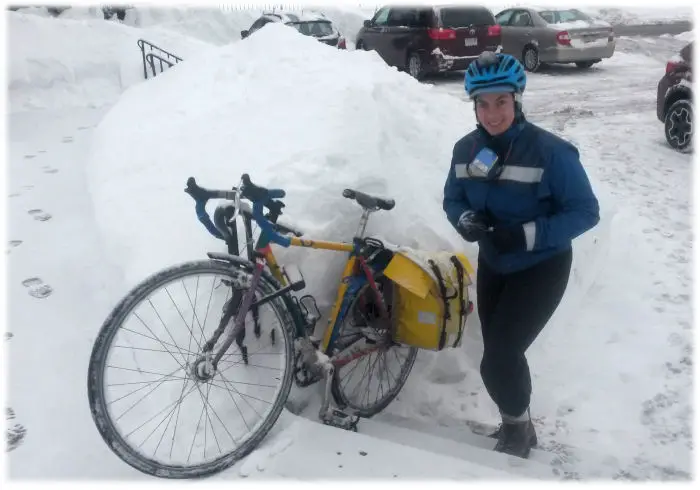
My own main winter bicycle is my usual city bike, my Raleigh Twenty folder. I'll ride one of my sportier bicycles in winter if the streets are clear and I'll be riding entirely in daylight -- mostly on recreational rides. If you will be doing a lot of riding on snow, check out the Icebike Web site -- see the link at the end of this article.
.
Internal gears are a good option where terrain is a concern. My Twenty in the photo has a Sturmey-Archer S5 5-speed hub, which gave me years of trouble-free service; I replaced it with a Shimano 8-speed as age caught up with me so I need lower gears for climbing. Older, oil-lubricated internal-gear hubs withstand winter well, because oil washes out grit and water. Many newer internal-gear hubs can be oiled by removing shifter parts and squirting oil into the end of the hollow axle. Most internal-gear hubs with a cable pulley inboard of the sprocket are grease-lubricated and must be rebuilt to relubricate them: see information on lubrication on our internal-gear hub page.
A conventional riding position lets you put a foot down if the going gets slippery, and a frame with low step-over height makes it easier to step off and walk. A recumbent bicycle is harder to manage on slippery surfaces, but if you fall, you don't fall as far. The photo below is of my wife, Elisse, on her Tour Easy recumbent on a cold, dry day in February, 1991, 8 1/2 months pregnant. She says that she could feel our son pedaling inside. She did have to leave off riding for the last few weeks before he was born, due to knee-belly interference.
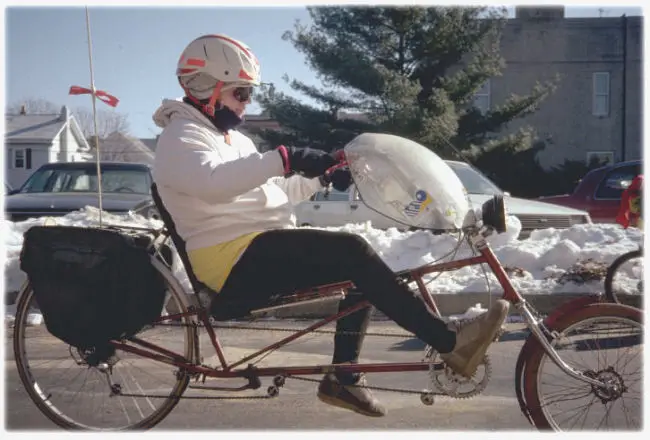
In extremely cold weather -- well below freezing -- lubricants may congeal, causing pawls not to engage ratchets, brakes not to release, and chains in a derailer drivetrain to skip. Lighter lubricants can avoid this problem.
With rim brakes, rim wear from rim brakes is a concern on sanded streets. Check rims for thinning of the sidewalls, and expect to replace rims every couple of years if you ride much in winter in stop-and-go traffic. Rim brakes also are less effective when wet, though this is much less of a problem with modern aluminum rims than with the steel rims of yesteryear. Hub brakes -- disc, drum or coaster -- avoid these problems. Older bikes and road bikes usually don't have fittings to install disc brakes, but you could install a front disc brake on a replacement fork. A drum brake, on the other hand, can be installed on any frame or fork. Drum brakes are weatherproof, and OK except for speed control on long downhills, when they can overheat. A coaster brake is another option for the rear wheel, though a bicycle should also have a front-wheel brake. See our articles on bakes for more detail.
Don't let this happen!
![]()
![]()
Preferred tire width depends on conditions. Narrow tires carve into soft, new snow and rest on the surface underneath. Wider tires ride on top of packed snow, and are less likely to be diverted by an uneven surface: As this is written, "fatbikes" with ultra-wide tires are becoming popular for riding on packed snow. You might consider puncture-resistant tires, or ones with a deeper tread, to reduce the chance of a flat, because fixing a flat with cold hands is no fun. Carry a spare inner tube, so you can save patching for later. Though a tire can be patched without removing the wheel, a fixed gear, single-speed or derailer rear wheel can have a quick release, making it easier to replace the inner tube instead.
Studded tires increase traction when riding on ice or packed snow. Steel studs wear quickly; carbide studs are preferable. It's best to keep a separate bicycle or separate set of wheels with studded tires, so you use them only when you need them. They do slow you down.
Electrical assist is very helpful to make pedaling easier with studded tires and when compacting snow, slush or mud, but only torque-sensing maintains full, momentary control over power output. That can be essential to keep power near the limit without breaking traction. Batteries release power more slowly in cold weather, and so you may want to keep he battery indoors between rides.
Except for hard-core off-roaders riding in clean snow, full fenders are essential to keep road sand, salt and melting snow off you and the bicycle. Also see our article about fenders. Note (as described in the article) that many racing-style road bikes have clearance only for narrow tires, and have no eyelets to mount fender braces. Fenders should be aligned so they are farther from the tire at the front, so slush and snow are ejected rather than packing in place.
You are going to need lights on your bicycle unless you restrict your riding to the middle of the day.
Cold air can make your nose run. A handlebar bag is good to carry a washcloth to wipe your nose. (There's an estimable organization in Boston, Bikes Not Bombs, which teaches young people how to work on bicycles, and collects discarded bicycles to ship to third-world countries. Sheldon used to make a play on words...I'll stop here.) The handlebar bag can also carry tools and excess layers of clothing, and a snack.
Water in a water bottle can freeze; a salted or sugared drink will stay liquid to a lower temperature; you may carry a drink inside the handlebar bag for some insulation, or use a hydration backpack on longer rides - but then, its hose can freeze up.
Slush can freeze up and immobilize parts of a bicycle when it is parked-- so, you may need to bring it into a heated space to thaw. Even if the tires are only wet, road salt and sand will leave a dirty little puddle under each wheel. A plastic sheet can catch the mess.
If you have stored the bicycle indoors, brakes and shifters may work fine when you test them at the start of a ride, and freeze up after a few minutes. This happens with a length of cable housing which is higher at the ends, so water can settle in the middle. Avoid cable runs which can trap water.
Road salt is hard on bicycles. Hosing the bicycle off after a ride works well to clean it. Avoid high-pressure spraying, which contaminates bearings. You could keep a garden sprayer indoors where it doesn't freeze up, and take it outside to wash the bicycle.
I give my winter bicycle a thorough spring cleaning, and overhaul parts as needed, once warm weather returns. Chain wear is fastest in winter, and so I replace the chain and sprocket in the spring to get the most use out of them.
![]()
![]()
Keeping your engine, the legs, warm. If the temperature is below 40 degrees Fahrenheit (5 degrees Celsius), you should be wearing two layers on your legs. Long underwear or tights work well as your base layer. Cross-country skiing clothing works for bicycling. I defy fashion and wear corduroy trousers over sweatpants. The photo below shows me on a clear winter day with temperatures in the 20s Fahrenheit (around -5 Celsius). I was comfortable!
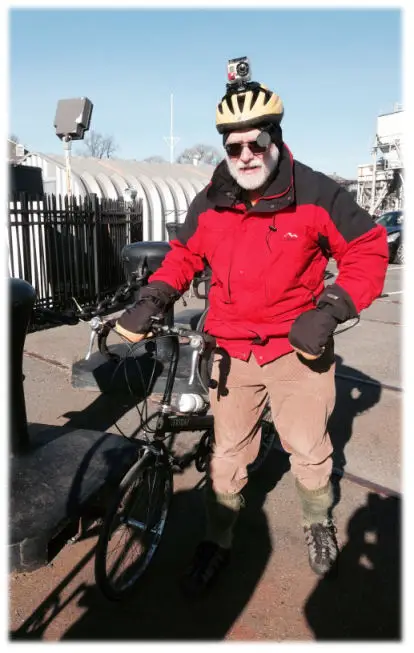
Exercise warms you but soggy clothing can chill you right down. You get wet if you overdress and sweat. Wear clothing in layers above the waist, so you can adjust as you warm up. I usually wear a windshell jacket with polypropylene (Polartec) fleece jacket and shirt underneath. I can remove the fleece jacket if I get too warm. If the temperature is well below freezing, as in the photo above, my outer layer is a parka.
Zipper fronts and underarm vents allow for quick adjustment as you warm up and cool down. You might tie string or yarn to the zipper tabs to make them easier to adjust with gloved hands. A chest-level zippered pocket is good to hold a smartphone or GPS unit, so it can read out directions to you.
My friend Pamela Murray uses arm warmers and leg warmers -- unattached sleeves that you can roll down around your wrists and ankles as you warm up. You don't have to remove or replace any items of clothing. There is a link to her description of her clothing system at he end of this article
A rainy day with the temperature hovering around freezing is the most challenging, and for these conditions you need a rain cape or Gore-Tex jacket. Falling snow at temperatures below freezing drops off your clothing rather than sticking to it -- actually less of a challenge.Fabric choices matter. Cotton has a bad reputation for holding moisture and becoming clammy. Synthetic fabrics generally shed water, but they can collect odors. Wool insulates even when wet. It has a reputation for being scratchy when worn next to the skin, but modern wool blends, merino wool and mohair are soft and comfortable. Wool undershirts are available now.
A watch cap goes under the helmet. You remove the cap as you warm up, if the temperature is above freezing. You may also tape over the helmet's ventilating holes, as Sheldon liked to do, or use a helmet cover. Yes, a beard helps keep the face warm too (Sorry, gals!).
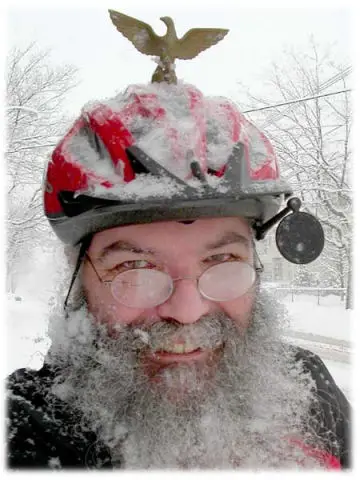
In the photo, Sheldon's glasses have fogged. That is most likely to happen when stopping, and when the air is cold but humid. Warm, moist breath rises then, rather than blowing past your face.
The photo below is of my friend from Maine, John Brooking, suited up to ride when the temperature is -6 F (-21 C) with a wind chill of -19 F (-28 C). John describes the head covering as of Polartec material, of the style called "headsokz", available by searching on that word.
Arrange a balaclava or neck warmer so you breathe out through it, or downwards, so you do not fog your glasses or goggles. Do not use a long scarf which could tangle in the spokes!
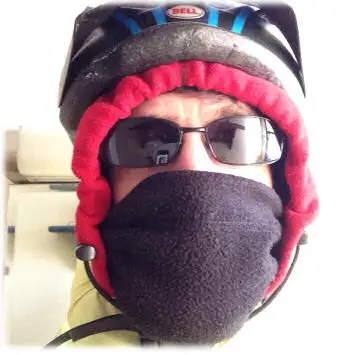
For the hands, wear insulated mittens with a windshell outer layer. Pearl Izumi lobster gloves are very warm. I have had good luck with military surplus trigger mittens with wool liners. They're sold online. Have lighter gloves for temperatures above freezing. Bar Mitts are shields that fit over the handlebar ends to keep he cold wind off your hands.
Strategies to keep the feet warm all amount to having a thick enough layer of insulation and a windshell on the outside. Participants in the 2015 Charles River Wheelers bicycle club New Year's Day ride posed for the fashion photo below. The temperature was below freezing.
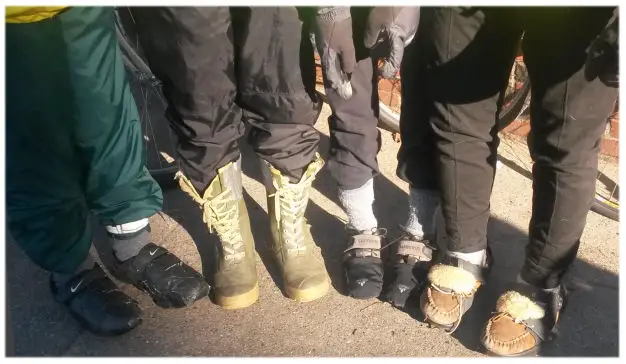
Left to right:
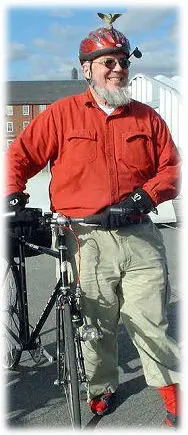 Richard had an inspiration to tear off the worn-out soles of his moccasins and use the tops with his Shimano SPD sandals. While the soles of the usual cleated bicycle shoes are about 1/4" thick, the soles of the sandals are about 1/2" thick, so the cleats don't conduct the cold through to his feet.
Richard had an inspiration to tear off the worn-out soles of his moccasins and use the tops with his Shimano SPD sandals. While the soles of the usual cleated bicycle shoes are about 1/4" thick, the soles of the sandals are about 1/2" thick, so the cleats don't conduct the cold through to his feet.
Sheldon also liked to wear SPD sandals in winter. The photo at the left is from the New Year's Day ride in 2004, when the temperature was a few degrees above freezing. Sheldon explained that the sandals don't cut off circulation to the feet, as shoes do. I've tried this. It works.
Everyone except Eric Ferioli in the footwear photo is using Shimano SPD clipless pedals. The SPD system, designed for off-road use, is good at clearing mud, sand and snow, and the shoes are walkable. Like Eric, you may prefer flat pedals, and thick, heavy insulating boots, such as Army Mickey Mouse boots, especially in extremely cold or sloppy weather. They make it easier to put a foot to the ground if you skid.
I've worn sandals too, but usually I wear slightly oversize Specialized Body Geometry shoes with two pairs of wool socks and Shimano SPD cleats. Like Ellen in the photo above, I pull the socks up over my trouser cuffs to seal against cold air and to keep the cuffs away from the chain.
Eyeglasses help keep cold air out of your eyes. Wear goggles if you don't wear eyeglasses, or with eyeglasses under extreme conditions, to avoid fogging, A sunny winter day with snow on the ground is brighter than summer, so lenses should be tinted. John Brooking recommends pulling the balaclava down when stopped to avoid fogging his glasses. He also times exhaling to coincide with turning his head to look back for traffic, so he isn't blowing moist air back into his face.
Eyeglasses also fog up when you come indoors, and will collect some grime and saltwater spatter. Running warm water over the eyeglasses will dispel the fog. Do not use hot water, which damages plastic lenses. I rinse the lenses, dab a fingertip on a bar of soap, spread the soap around on the lenses and rinse again. Avoid using moisturizing soap, which leaves smears on the lenses. Finally, I dab the lenses with a paper towel to dry them off -- but don't wipe: you could scratch the lenses. Give the tissues a sniff test: avoid using scented tissues, which also will smear the lenses.
Carrying a second pair of glasses in an inside pocket is another way to solve the fog problem when you come indoors.
![]()
![]()
Winter offers challenges to riding technique: slippery surfaces; roads and paths narrowed or blocked by plowed snow; and longer nights.
If snow has only started to fall, the main risk is of skidding. As long as new snow is an inch or less deep, it still reveals most surface defects. Preferably get home before the snow gets deeper. When show is deeper and the streets haven't been cleared yet, unless you're hard-core, it's time to put the bicycle aside and get out the cross-country skis or snowshoes.
Most streets in the USA are plowed within a day or two after snow has fallen, sometimes within hours. The snowplow leaves a thin layer of packed snow, but road salt, sunlight and pounding from car tires help to clear it. Drains at the edge of the street channel meltwater away. The main, traveled part of the street is usually clear of snow within a few days after a storm. Often, if the temperature is above freezing or the street is salted, the surface will be wet, but if your bicycle has fenders, riding on a dry day on a wet surface can be more pleasant than riding on a warm, rainy day.
Still -- plowed snow often narrows the street, and meltwater refreezes into ice at the edges where water runs to the drains. After snow melts, the edge of the street will still be littered with sand and debris. Often, this is not cleaned away until the snow season is completely over.
Mt. Auburn Street gutter bike lane, Cambridge, Massachusetts:
weeks since the last snow, but
assertive lane positioning is required.

Because of the narrowed streets, bicycle driving technique is essential. Control of the travel lane is needed more of the time than in other seasons. Resources on safe cycling can be found in my Bicycling Street Smarts tutorial, online and in print; also in classes taught by certified instructors in the CyclingSavvy program, League of American Bicyclists Smart Cycling program, Can Bike program in Canada, and the Cycling Proficiency program in the U.K. -- see links at the end of this article.
The video below compares a street and parallel path under winter conditions, several days after a snowstorm.
winter-intro from John Allen on Vimeo.
Black ice forms when freezing rain, or runoff, as shown in the video, coats the riding surface. Black ice is treacherous: the surface may only look wet.
Frozen puddles can occur anywhere drainage is poor, including poorly-maintained streets. Ice ruts form when a brief thaw and refreezing occurs, as in the photo below, or when rain falls onto snow, then freezes.
After a one-inch snowfall, light thaw and refreeze, January 9, 2015:
Segregation on Eads Street, Arlington, Virginia,,
cars left, bikes right, in the ice ruts. The regulatory
sign indicates that bicyclists are required by law to use the bikeway.
This sign is not supported by law.
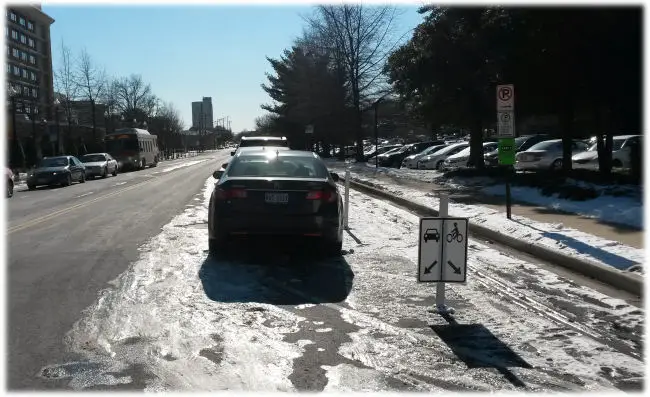
Though the blizzard of 1978 is the most memorable in recent Boston history, 1977 also was memorable for a snowfall which changed to rain, then froze, leaving a layer of packed ice-crusted snow on the streets. This broke up into patches as vehicles rolled over it, and they didn't completely clear up for weeks. I managed to keep riding by staying alert and riding around them, and at times walking.
Heavy salting is needed to prevent refreezing on surfaces which don't drain properly, as in the example below.
9th Avenue, Manhattan: this bikeway is wide enough for a snowplow truck
but snow plowed nearer the center of the crowned roadway
melts onto the bikeway and risks freezing into black ice
despite heavy salting. Photo credit: Lynette Chiang.
And then there are potholes as freeze-thaw cycles break up pavement...
![]()
![]()
I don't mean to be discouraging. Surface hazards in winter aren't much different from those in other seasons, they are just more common. I'll be happy to ride anytime the streets are mostly clear of snow.
When there may be ice or snow ahead, be attentive and cautious and be prepared to put a foot down. On a slippery surface, ride at a moderate speed, so you don't have to brake sharply or lean far into turns. Remember that on a slippery surface, a front-wheel skid will dump you, so avoid using the front brake. Be aware of where vehicles may be approaching on a slippery surface and unable to stop, and keep clear till the potential hazard has passed.
But also, there are major advantages in getting around by bicycle in winter. You u are getting exercise and stoking your internal heater, not standing shivering at a bus stop. Unlike the car driver, you don't have to dig your bicycle out. You don't get stuck and have to call a tow truck. You have better traction for hill climbing than most motor vehicles, because you can use body English to put almost all your weight over the rear wheel. As each pedal goes down, you slide forward to transfer weight to the rear wheel; then slide back to scoot the bicycle forward as the pedals go through the dead center.
I'll end this section of the article with a photo from Cambridge, Massachusetts on a fine, sunny day a couple of days after the legendary Blizzard of 1978. Only the main streets had been plowed by then, and use of private motor vehicles was prohibited. For a few days, the streets, which still held a layer of snow and slush -- were populated by tow trucks, snowplow trucks -- and bicycles. You could walk, or ride a bicycle to get around, but you got much farther on a bicycle.
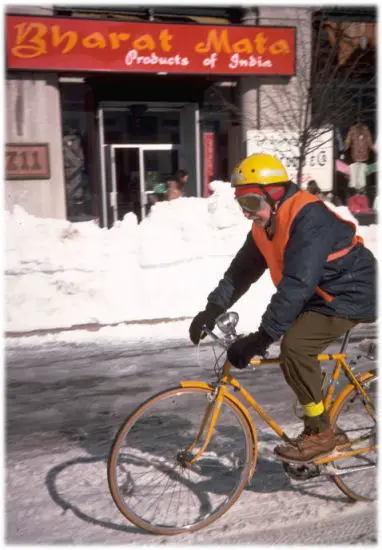
If you're like me, you need to catch some sun and get some exercise to avoid the winter blues, or seasonal affective disorder (same thing, 50-cent word).
By riding your bicycle in winter, you have outdoor exercise starting at your doorstep. People drive from Boston to Vermont or New Hampshire to ski down mountains at high speeds, and in colder weather. They still ask how I can ride in winter.
Winter cycling does have its challenges, as described earlier in this article, but part of the enjoyment of winter cycling is in meeting those challenges. The winter landscape also has its beauty, in subtle colors, bright sunlight reflected off snow, and longer vistas through leafless woodlands.
If you've equipped yourself well so you are comfortable riding; if you choose quiet roads or quiet times; if you are a skillful urban cyclist, than winter riding can be entirely enjoyable. You can't just stop, lie down on a grassy town green and rest, and so long-distance recreational riding is less popular in winter. Added time in preparation makes the shortest rides more of a hassle. But for rides with a set destination, winter riding can be very practical, and you will feel better for it.
![]()
![]()
Last Updated: by John Allen